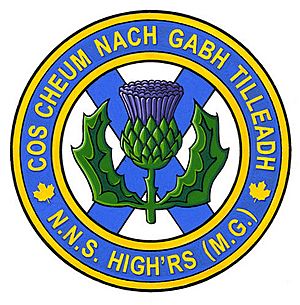North Nova Scotia Highlanders facts for kids
Quick facts for kids The North Nova Scotia Highlanders |
|
|---|---|

Badge of The North Nova Scotia Highlanders
|
|
| Active | 1936–1954 |
| Country | Canada |
| Branch | Canadian Militia (1936-1940) Canadian Army (1940-1954) |
| Type | Line infantry |
| Role | Infantry |
| Size | One battalion |
| Part of | Non-Permanent Active Militia (1936-1940) Royal Canadian Infantry Corps (1942-1954) |
| Garrison/HQ | Amherst, Nova Scotia |
| Motto(s) | Scottish Gaelic: Cos cheum nach gabh tilleadh, lit. 'Our footsteps will not allow us to go backwards' |
| Colors | Facing colour white |
| March | Quick – "The Atholl Highlanders" |
| Engagements | Second World War |
| Battle honours | See #Battle Honours |
| Insignia | |
| Tartan | Murray of Atholl |
The North Nova Scotia Highlanders was a brave infantry regiment in the Canadian Army. It was formed in 1936. In 1954, this regiment joined with another, The Pictou Highlanders, and a special anti-aircraft battery. Together, they became the 1st Battalion, The Nova Scotia Highlanders (North).
Contents
History of the Regiment
The North Nova Scotia Highlanders started in 1936. It was created by combining three different groups: The Cumberland Highlanders, The Colchester and Hants Regiment, and a machine-gun company. At first, it was called The North Nova Scotia Highlanders (M.G.). In 1941, its name was shortened to its current title.
This regiment played a big part in the Second World War. They landed on Juno beach on D-Day, June 6, 1944. This was a very important day for the Allies in Europe. They were part of the 9th Canadian Infantry Brigade and the 3rd Canadian Infantry Division.
In 1954, the regiment changed again. It joined with The Pictou Highlanders and the 189th Light Anti-Aircraft Battery. They formed a new unit called the 1st Battalion, The Nova Scotia Highlanders (North). Before this change, the North Nova Scotia Highlanders were ranked 34th in the Canadian Army's order of importance.
How the Regiment Was Formed
The North Nova Scotia Highlanders was created from older military units. Here's a simple look at how it came to be:
The Cumberland Highlanders
This unit began in Amherst, Nova Scotia, in 1871. It changed its name a few times over the years. For example, it was known as the 93rd Cumberland Battalion of Infantry and later The Cumberland Regiment. In 1927, it became The Cumberland Highlanders. In 1936, it joined with other units to form the North Nova Scotia Highlanders.
The Colchester and Hants Regiment
This regiment started in Truro, Nova Scotia, in 1910. It was first called the 70th Colchester and Hants Regiment. After some changes, it became The Colchester and Hants Regiment. In 1936, it joined with The Cumberland Highlanders and a machine-gun company to create the North Nova Scotia Highlanders.
The 81st Hants Regiment
This unit began in Windsor, Nova Scotia, in 1914. It was first known as the 68th Regiment. In 1920, it joined with the 76th Colchester and Hants Rifles to form The Colchester and Hants Regiment.
Honoring Past Units
The North Nova Scotia Highlanders carried on the traditions and history of several units from the past. This is called "perpetuation."
Great War Units
The regiment honored these units from the First World War:
- 25th Battalion (Nova Scotia Rifles), CEF
- 106th Battalion (Nova Scotia Rifles), CEF
- 193rd Battalion (Nova Scotia Highlanders), CEF
Uniform and Friends
The North Nova Scotia Highlanders had a special uniform. They wore a blue hat called a glengarry with a checkered pattern. Their jacket was scarlet, and they had a white sporran (a pouch worn in front of the kilt) with black points. They also wore scarlet and green socks with green garter flashes. This full uniform was mainly for pipers and drummers.
The regiment was allied with the South Staffordshire Regiment. This meant they had a special friendship and connection with that British Army unit.
Battle Honours
Battle honours are special awards given to military units for their bravery and success in battles. Only the honours written in all capital letters were displayed on the regiment's special flag, called a guidon.
- War of 1812
- DEFENCE OF CANADA – 1812–1815 (a special award)
- Boer War
- First World War
|
- Second World War
|
|
|
Ardenne Abbey Incident
During the Second World War, a German officer named Kurt Meyer was involved in illegal actions against captured soldiers from this regiment near Ardenne Abbey.
After the war, he was held responsible for his actions. He was tried in Canada and found guilty in December 1945. His punishment was changed to life in prison in January 1946. After spending almost nine years in prison, Meyer was released in September 1954.
See also

